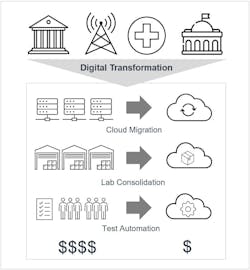Where is Telecom Tech Heading in 2024?
This article is part of the TechXchange: 5G Infrastructure.
What you’ll learn:
- Augmented and extended reality will outgrow gaming to enable remote maintenance.
- Private networks could emerge as the “killer app” on the enterprise level.
- For network operators, digital transformation and network digital twins are on the horizon.
If you’re a telecom fortune teller, you can always predict that service providers and their customers will want ubiquitous and faster access to digital solutions and services with greater reliability. But trying to forecast much beyond that gets dicey. The market moves quickly, and even with the most up-to-date information, you can still be surprised (as in generative AI’s explosion onto the scene in 2023).
As a leading provider of network testing and validation solutions, Spirent occupies a unique perch in the industry that gives us an edge in the predictions game. Based on our conversations with network operators and vendors, and the technologies they’re testing right now, here are the top trends we expect for the coming year.
AR/XR Gets Down to Business
Augmented-reality and extended-reality (AR/XR) applications have been much discussed in recent years, though usually in the context of consumer applications and gaming. Those are still big potential markets—especially considering the huge investments made by companies like Apple and Samsung to roll out premium AR/XR headsets in 2024. Just as exciting, however, is the market for enterprise AR/XR solutions that will begin growing in earnest this year.
For companies with large footprints of distributed assets (like operators of pipelines, power grids, EV charging stations, and even telecoms themselves), AR offers more than fun and games. By enabling remote maintenance and guided repairs, for example, it can help address some of their biggest business challenges. With overlaid schematics and guided repairs, even less-skilled personnel can install and fix equipment without waiting for an expert technician to arrive—potentially saving millions.
As AR/XR adoption grows this year, service providers will need to build up capabilities to monitor and guarantee quality of experience (QoE) for users. Look for QoE targets to expand beyond traditional performance metrics to address other characteristics, such as thermal (as in, “how hot do headsets get?”), battery life, weight, and comfort.
AI Drives Need for Data-Center Speed
Spiking demand for AI is already triggering massive investments by cloud service providers to build out AI fabrics. Those efforts will continue this year as data-center operators seek to beef up both back-end large learning clusters and front-end inferencing—including faster interconnect technologies. Based on what we’re seeing behind the scenes, Ethernet will dominate AI networks.
At the front end, cloud providers will increasingly adopt 800G Ethernet as new 51.2-Tb/s switches reach the market. In the back end, cloud service providers will start using new network designs this year and in 2025 that allow for high-speed Ethernet as a viable option. In fact, due to the huge volume of processing required by AI, we expect more cloud service providers to view Ethernet as essential for the long-term evolution of their AI infrastructure.
Private Networks = Killer App for Enterprises?
Whether for AI or other edge applications with demanding throughput, latency, and other requirements, many businesses now recognize how valuable it is to have custom local networks tuned for their critical business applications. In 2024, look for enterprise private networks to shift from “interesting proof-of-concept” to “meaningful source of revenues” for service providers and cloud providers.
After seeing the success of early trials last year (most of which generated an ROI within six months), enterprises are keen to expand their private-network footprints, especially for applications such as:
- Industrial “AI vision” supply-line monitoring and fault detection
- AR/XR remote maintenance and guided repairs
- Secure government and military networks, especially in remote and inhospitable locations
According to a recent STL Partners survey, use cases like these are becoming so valuable that customers will pay a premium for them—provided operators can guarantee business outcomes under service-level agreements. Given that the most compelling private network use cases also require local processing, look for more telecoms and cloud providers to partner in this space on combined compute + connectivity offers.
5G Core Deployments Go Global
Last year saw slower-than-expected growth in 5G core adoption and 5G standalone (SA) deployments, as operators wrestled with early technical challenges. This year, though, we expect deployments to start accelerating in earnest, simply because the market is now fully aligned for it.
Unlike at this time last year, there’s a more vibrant, growing ecosystem of 5G SA suppliers. Currently, 17 network equipment vendors, more than 80 modem and chipset options, and more than 1,400 device types on the market support 5G SA. We’re also seeing a spike in testing among operators preparing to launch premium 5G SA services like network slicing, Voice over 5G New Radio (VoNR), and reliable low-latency solutions for industrial applications.
On the demand side, customers increasingly want capabilities that only next-gen networks can provide, such as custom network slices, private networks, and support for AR/XR applications. In all, we expect more than 100 5G SA networks to come online by 2025.
Telecoms Chase Digital Transformation
Telecoms aren’t just looking to help their customers innovate; many are pursuing internal digital transformation initiatives as well. This year, that will include ongoing efforts to migrate operational support system (OSS) and IT workloads to the public cloud, and to automate more aspects of network device lifecycle operations.
Initially, most automation initiatives will employ basic machine learning (ML) rather than full AI, due to lingering questions about maturity, the costs of building and training models, and regulatory uncertainty. But these efforts will represent a major step toward tomorrow’s fully AI-enabled, autonomous networks (see figure).
The most advanced service providers will also explore another cutting-edge operational innovation: network digital twins. Digital twins can help service providers minimize their reliance on time-consuming, error-prone manual engineering processes and lengthy maintenance windows.
Working with highly accurate, real-time virtual models of the network, service provider teams are able to thoroughly validate changes before applying them. They can experiment, evaluate, and learn more quickly how to optimize new service deployments, all while reducing errors and outages in the live network.
Read more articles in the TechXchange: 5G Infrastructure.
About the Author
Steve Douglas
Head of Market Strategy, Spirent Communications
Stephen Douglas is Head of Market Strategy for Spirent Communications, helping to define technical direction, new innovative solutions and market-leading disruptive technologies. With over 20 years’ experience in telecommunications, Stephen has been at the cutting edge of next generation technologies and has worked across the industry with service providers, start-ups, and network equipment and device manufacturers, helping drive innovation and transformation across the 5G ecosystem. Stephen is an ardent believer in connected technology and strives to challenge, blur and break down the silos that prevent innovation and business success.

